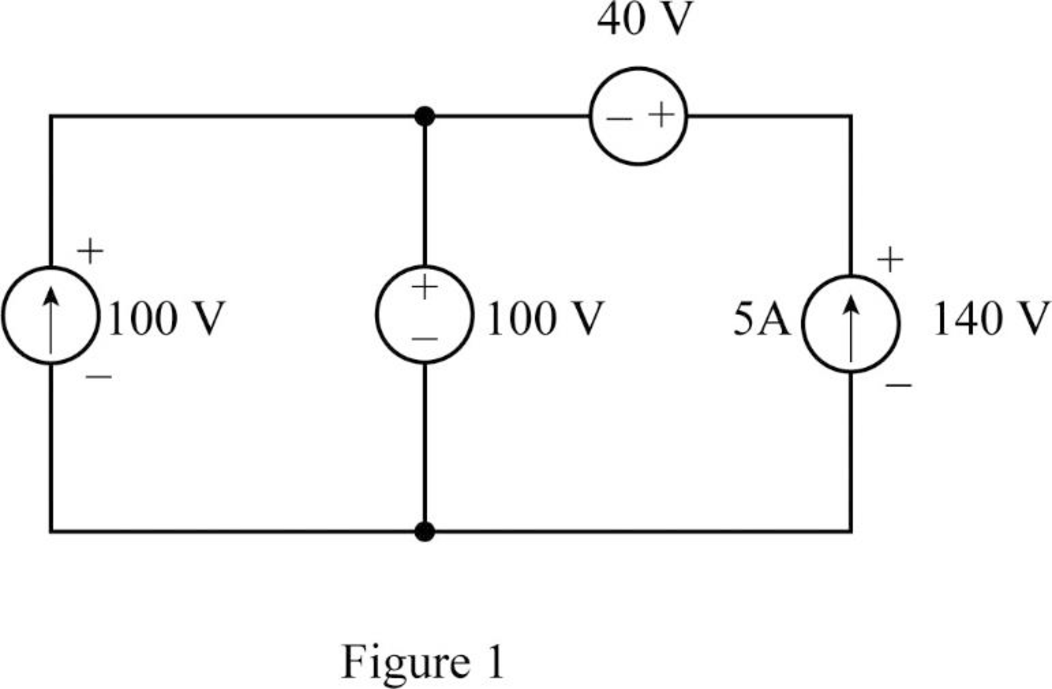
Verify whether the interconnection in the circuit in Figure P2.1 in the textbook is valid or not. Calculate the power developed by the current sources if the circuit is valid. Explain the reason if the interconnection in the circuit is not valid.
Answer to Problem 1P
The interconnection in the given circuit is valid and the power developed by the current sources is 1700 W.
Explanation of Solution
Given data:
Refer to Figure P2.1 in the textbook for required data.
Formula used:
Write the expression for power developed by the source (voltage or current) as follows:
Here,
Calculation:
From the given circuit, it is clear that, the voltage drop across the 10 A current source is 100 V and the voltage drop from the negative terminal of the 40 V voltage source to the bottom terminal of the 5 A current source must be 100 V.
In order to maintain the voltage drop of 100 V from the negative terminal of the 40 V voltage source to the bottom terminal of the 5 A current source the voltage drop across 5 A current source must be 140 V.
From the analysis, redraw the circuit as shown in Figure 1.

All the sources in the given circuit are independent sources. The independent voltage source can carry any current that required by the connection and the independent current source can support any voltage that required by the connection.
From the analysis, the voltage drop across the sources is satisfied. Therefore, the interconnection in the given circuit is valid.
Rewrite the expression in Equation (1) to find the power developed by the 10 A current source as follows:
From Figure 1, current 10 A enters from the negative terminal of 100 V. Therefore, the values of
The negative sign indicates the delivered power by the source. Therefore, the power developed by the 10 A current source is 1000 W.
Rewrite the expression in Equation (1) to find the power developed by the 5 A current source as follows:
From Figure 1, current 5 A enters from the negative terminal of 140 V. Therefore, the values of
As the negative sign indicates the delivered power by the source, the power developed by the 5 A current source 700 W.
Write the expression for power developed by the both current sources as follows:
Substitute 1000 W for
Conclusion:
Thus, the interconnection in the given circuit is valid and the power developed by the current sources is 1700 W.
Want to see more full solutions like this?
Chapter 2 Solutions
Electric Circuits, Student Value Edition Format: Unbound (saleable)
- help on this question about power electronics?arrow_forwardA speech signal has frequencies in the range 50- 3500 Hz. The signal is sampled at Nyquist sampling rate and the resulting pulses are transmitted over PAM and PCM systems. 1- Calculate the minimum bandwidth of the PAM system. 2- Calculate the minimum bandwidth of the PCM system, when the pulses are quantized into 121 levels B) Draw the signaling waveform (line codes) for the binary sequence 10110001 using (Unipolar NRZ, Bipolar RZ, Bipolar NRZ, Manchester code, Differential Manchester (split phase).arrow_forwardDon't use ai to answer I will report you answerarrow_forward
- Don't use ai to answer I will report you answerarrow_forward8-1) similar to Lathi & Ding, Prob. P.5.1-2 The figure below shows the Fourier spectra of signals of g,(t) and g₁(t). Determine the Nyquist rate and the corresponding sampling interval for signals of g,(t), g,(t), g₁(1) - g¸(1), g¸³(t), and g₁(1)g₁(1). Hint: Use the frequency convolution and the width property of convolution. G₁(f) G₂(f) -8000 0 8000 f -20000 10 20000 farrow_forward• We will use the Wattmeter to find the average power supplied/absorbed by each component. The following figure shows how to connect the Wattmeter to measure the average power absorbed by the resistor. Note that the Wattmeter consists of a Voltmeter and an Ammeter. The Voltmeter must be connected in parallel with the component and the Ammeter must be connected in series with the component. You must pay attention to the polarity of the voltage across the component as well as the direction of the current flowing through the component. 5Vpk 1kHz 30° ww 40 Z=A-JB Wattmeter-XWM1 2.503 W Power factor: 1.00000 Voltage Current • • Similarly connect a second Wattmeter to measure the average power supplied by the source. Connect a third Wattmeter to measure the average power in the capacitor. Does this value agree with the theoretical value? Perform Interactive Simulation under Analysis and Simulation. Double click on Wattmeters to see the average power values. Note that the Wattmeter also…arrow_forward
 Introductory Circuit Analysis (13th Edition)Electrical EngineeringISBN:9780133923605Author:Robert L. BoylestadPublisher:PEARSON
Introductory Circuit Analysis (13th Edition)Electrical EngineeringISBN:9780133923605Author:Robert L. BoylestadPublisher:PEARSON Delmar's Standard Textbook Of ElectricityElectrical EngineeringISBN:9781337900348Author:Stephen L. HermanPublisher:Cengage Learning
Delmar's Standard Textbook Of ElectricityElectrical EngineeringISBN:9781337900348Author:Stephen L. HermanPublisher:Cengage Learning Programmable Logic ControllersElectrical EngineeringISBN:9780073373843Author:Frank D. PetruzellaPublisher:McGraw-Hill Education
Programmable Logic ControllersElectrical EngineeringISBN:9780073373843Author:Frank D. PetruzellaPublisher:McGraw-Hill Education Fundamentals of Electric CircuitsElectrical EngineeringISBN:9780078028229Author:Charles K Alexander, Matthew SadikuPublisher:McGraw-Hill Education
Fundamentals of Electric CircuitsElectrical EngineeringISBN:9780078028229Author:Charles K Alexander, Matthew SadikuPublisher:McGraw-Hill Education Electric Circuits. (11th Edition)Electrical EngineeringISBN:9780134746968Author:James W. Nilsson, Susan RiedelPublisher:PEARSON
Electric Circuits. (11th Edition)Electrical EngineeringISBN:9780134746968Author:James W. Nilsson, Susan RiedelPublisher:PEARSON Engineering ElectromagneticsElectrical EngineeringISBN:9780078028151Author:Hayt, William H. (william Hart), Jr, BUCK, John A.Publisher:Mcgraw-hill Education,
Engineering ElectromagneticsElectrical EngineeringISBN:9780078028151Author:Hayt, William H. (william Hart), Jr, BUCK, John A.Publisher:Mcgraw-hill Education,





